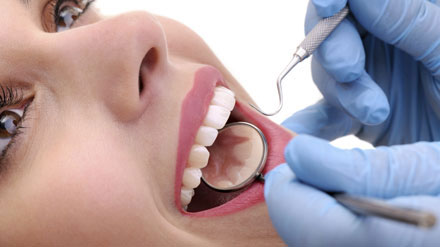Nonsurgical treatment of periodontitis for persons with diabetes does not improve glycemic control
For persons with type 2 diabetes and chronic periodontitis, nonsurgical periodontal treatment did not result in improved glycemic control, according to a study appearing in the December 18 issue of JAMA.
Emerging evidence implicates inflammation in the development of type 2 diabetes. Chronic periodontitis, a destructive inflammatory disorder of the soft and hard tissues supporting the teeth, is a major cause of tooth loss in adults. Nearly half of the U.S. population older than 30 years is estimated to have chronic periodontitis, according to background information in the article. Individuals with diabetes are at greater risk for chronic periodontitis. Well-controlled diabetes is associated with less severe chronic periodontitis and a lower risk for progression of periodontitis, suggesting that level of glycemia is an important mediator of the relationship between diabetes and risk of chronic periodontitis. Limited evidence suggests that periodontal therapy may improve glycemic control.
Steven P. Engebretson, D.M.D., M.S., M.S., of New York University, New York, and colleagues examined whether nonsurgical periodontal therapy, compared with no therapy, reduces levels of glycated hemoglobin (HbAlc) levels in persons with type 2 diabetes and moderate to advanced chronic periodontitis. The trial included 514 participants who were enrolled between November 2009 and March 2012 from diabetes and dental clinics and communities affiliated with 5 academic medical centers. The treatment group (n = 257) received scaling and root planing plus an oral rinse at baseline and supportive periodontal therapy at 3 and 6 months. The control group (n = 257) received no treatment for 6 months.
The researchers found that levels of HbAlc did not change between baseline and the 3-month or 6-month visits in either the treatment or the control group, and the target 6-month reduction of HbAlc level of 0.6 percent or greater was not achieved. There were no differences in HbAlc levels across centers.
Periodontal measures improved in the treatment group compared with the control group at 6 months.
Periodontists are dentistry’s experts in treating periodontal disease. They receive up to three additional years of specialized training in periodontal disease treatment in both non-surgical treatments and periodontal plastic surgery procedures. Periodontists are also experts in replacing missing teeth with dental implants.
Treatments and Procedures ›
Non-Surgical Periodontal Treatment
Non-Surgical Periodontal Treatment
AAP treatment guidelines stress that periodontal health should be achieved in the least invasive and most cost-effective manner. This is often accomplished through non-surgical periodontal treatment.
Non-surgical periodontal treatment does have its limitations. When it does not achieve periodontal health, surgery may be indicated to restore periodontal health.
Scaling and Root Planing
Scaling and root planing is a careful cleaning of the root surfaces to remove plaque and calculus [tartar] from deep periodontal pockets and to smooth the tooth root to remove bacterial toxins. Scaling and root planing is often followed by adjunctive therapy such as local delivery antimicrobials and host modulation, as needed on a case-by-case basis.
Most periodontists would agree that after scaling and root planing, many patients do not require any further active treatment. However, the majority of patients will require ongoing maintenance therapy to sustain health.
Tray Delivery Systems
A tray delivery system consists of a custom-fit tray made from impressions of the patient’s mouth. Patients use the tray at home to deliver medications that have been prescribed by their dentist. Tray delivery systems were cleared by the Food and Drug Administration (FDA) since they are similar to fluoride trays traditionally used to prevent Tooth decay. However, the FDA clearance process did not determine that any specific medication delivered via tray delivery systems has been proven to be a safe or effective way to treat gum disease. Additionally, numerous clinical studies have suggested that topically applied medicines do not reach the source of periodontal infections. When determining the best course of treatment for your specific case, be sure to discuss the pros and cons of all available treatment options with your dental professional.
 “This multicenter randomized clinical trial of nonsurgical periodontal treatment for participants with type 2 diabetes and chronic periodontitis did not demonstrate a benefit for measures of glycemic control. Although periodontal treatment improved clinical measures of chronic periodontitis in patients with diabetes, the findings do not support the use of nonsurgical periodontal treatment for the purpose of lowering levels of HbAlc,” the authors conclude.
“This multicenter randomized clinical trial of nonsurgical periodontal treatment for participants with type 2 diabetes and chronic periodontitis did not demonstrate a benefit for measures of glycemic control. Although periodontal treatment improved clinical measures of chronic periodontitis in patients with diabetes, the findings do not support the use of nonsurgical periodontal treatment for the purpose of lowering levels of HbAlc,” the authors conclude.
###
(doi:10.l001/jama.2013.282431; Available pre-embargo to the media at media.jamanetwork.com)
Editor’s Note: Please see the article for additional information, including author contributions and affiliations, financial disclosures, funding and support, etc.
###
Elyse Bloom
.(JavaScript must be enabled to view this email address)
212-998-9910
The JAMA Network Journals